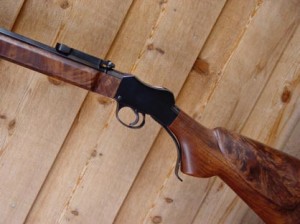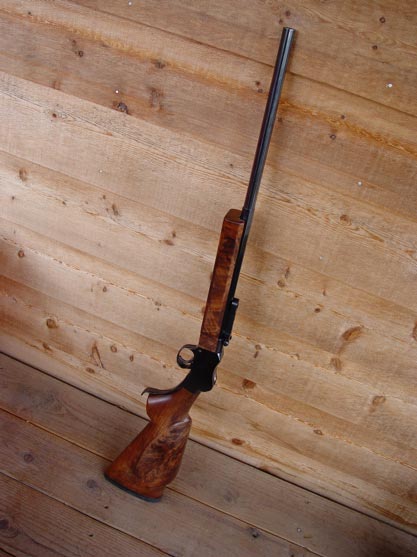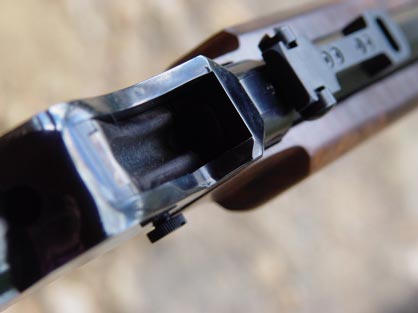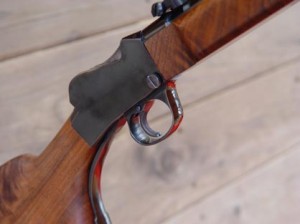This article was originally published on DRTV and the Michael Bane Blog on May 2, 2006. This rifle is also featured in a segment of Shooting Gallery episode #167.

Okay, I think I know everybody in the business, and mostly I do. But sometimes, I am just dead bang wrong! Here’s a case in point.
I met gunsmith Vic Samuel from SSA Enterprises through his son, Alan, who’s a machine gun guy and a revolver competition champion, while filming the first episodes of SHOOTING GALLERY. You saw Alan in our very first machine gun episode and in the 3-gun cop match in Colorado. Vic had a bit part in the machine gun show.

When I met Vic, he mentioned in passing that he “fiddled around with guns.” Eventually Alan let drop that his Dad built custom Martini Cadets. Okay, that’s obscure!
Essentially, Martini Cadets are small-framed versions of the famous Martini-Henry single shot rifles…think “Zulu!” the movie. Martini-Henrys have been around since the end of the 19th Century, but the Cadets, made for training (hence “Cadet”) and target competition, take from the early 1900s.

You can find out everything you ever wanted to know about Martinis here and here.
“The world famous BSA Martini rifles were manufactured from 1909 until phased out in 1955 when the last 12/15 was shipped. The International models were introduced in 1950 and phased out by 1986. Internationals were greatly improved for .22 target work, although the original models were far more versatile for conversion to other calibers.”
Apparently the little guys were popular with Sir Arthur Conan Doyle, but sadly he never thought to have Holmes and Watson put them to use.

Truth be told, I hadn’t thought about Martini Cadets in ages, but when I was a kid I had a BIG JONES for a converted .357/.38 one. The most common caliber of the small Martinis was .310 Rook, which lobbed a 120-grain bullet at about 1200 fps. That made the gun ideal for a .357 or a .32/20 conversion. I don’t know why I got all torqued up about the .357, except maybe that my father had no time for “obsolete” cartridges like the .32/20 and believed in the .357 Maggie the way some of my relatives believed in Elvis.
I eventually talked to Vic about an “homage’ to the gun I wanted when I was growing up —. 357 Magnum caliber; fat, wide benchrest-style forend; ’60s-style walnut stock; half-round/half-octagonal barrel, etc.
While it wasn’t at the top of my custom guns list, I asked what kind of money we’d be talking about. “Oh, say $1600 or so for a shooter, nothing special,” he said.
“Sold,” I replied. That’s about three Glocks these days. Or one 1911 that won’t work, plus $600 in gunsmithing to get it running!
I picked up my custom Martini Cadet yesterday, and I have to say I am FLOORED!
This is an amazing rifle — breathtaking workmanship — and this is Vic’s “Shooter Grade” gun!
He sourced and converted a Cadet to .357 Magnum; carved a “shooter grade” walnut stock to match the one I sketched out; added a whole slew of replacement parts for the little gun that he designed and manufactured; added a really nice curved lever that he designed and manufactured; put on one of this own half-round/half-octagonal barrels that he manufactured…getting the picture here?
The finish is flawless, the custom walnut stock hand rubbbed, the trigger pull is perfect — always considered a problem on the small Martini actions. I’ve got to scope it before I shoot it, and I’ve got a great scope from my old pals Mickey Fowler’s and John Pride’s newest enterprise, PFI Industries, and I just ordered a set of rings.
I have to say, though, that on looks alone, this gun is a jewel.
If you told me there was a gunsmith I’d never heard of, who none of my friends had heard of, who I’d never read a word about, building these beautiful little rifles, I’d have scoffed at the idea. Boy, was I wrong!
